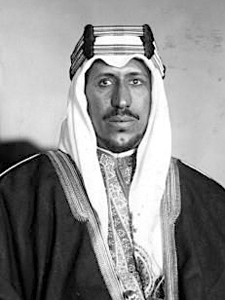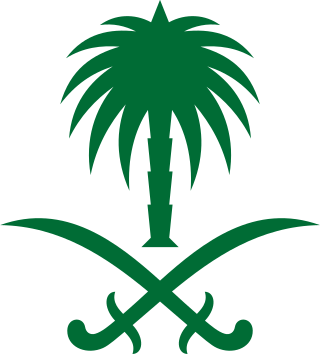
Riyadh, formerly known as Hajr al-Yamamah, is the capital and largest city of Saudi Arabia. It is also the capital of the Riyadh Province and the centre of the Riyadh Governorate.

Fahd bin Abdulaziz Al Saud was King and Prime Minister of Saudi Arabia from 13 June 1982 until his death in 2005. Prior to his ascension, he was Crown Prince of Saudi Arabia from 1975 to 1982. He was the eighth son of King Abdulaziz, the founder of modern Saudi Arabia.

Saud bin Abdulaziz Al Saud was King of Saudi Arabia from 9 November 1953 until his abdication on 2 November 1964. During his reign, he served as Prime Minister of Saudi Arabia from 1953 to 1954 and from 1960 to 1962. Prior to his accession, Saud was the country's crown prince from 11 May 1933 to 9 November 1953. He was the second son of King Abdulaziz, known as Ibn Saud, the founder of Saudi Arabia.

The House of Saud is the ruling royal family of Saudi Arabia. It is composed of the descendants of Muhammad bin Saud, founder of the Emirate of Diriyah, known as the First Saudi state (1727–1818), and his brothers, though the ruling faction of the family is primarily led by the descendants of Abdulaziz bin Abdul Rahman, the modern founder of Saudi Arabia. It forms a subtribe of the larger prominent ancient Banu Hanifa tribe of Arabia, of which well known 7th century Arabian theologist Maslama ibn Ḥabīb originates. The most influential position of the royal family is the King of Saudi Arabia, an absolute monarch. The family in total is estimated to comprise some 15,000 to 20,000 members; however, the majority of power, influence and wealth is possessed by a group of about 2,000 of them. Some estimates of the royal family's wealth measure their net worth at anywhere from $1.4 trillion to as high as $2 trillion. This figure includes the market capitalization of Saudi Aramco, the state oil and gas company, and its vast assets in fossil fuel reserves, making them the wealthiest family in the world and the wealthiest in recorded history.

Sultan bin Abdulaziz Al Saud, called Sultan the Good in Saudi Arabia, was the Saudi defense minister from 1963 to 2011 and the Crown Prince of Saudi Arabia from 2005 to 2011.
Abd al-Aziz, frequently also transliterated Abdul-Aziz, is a male Arabic Muslim given name and, in modern usage, surname. It is built from the words ʽAbd, the Arabic definite article and ʽAzīz "Almighty". The name is commonly abbreviated as "ʽAzīz". The name means "servant of the Almighty", al-ʽAzīz being one of the names of God in Islam, which give rise to the Muslim theophoric names.
Al Oud Cemetery is a public cemetery in al-Oud, Riyadh, Saudi Arabia, known for being the resting place of many kings, crown princes and royals of the second and current Saudi states. The word "al-ʿŪud", in Peninsular Arabic means "elder ", likely referring to King Abdulaziz, who was buried in the cemetery.
Mohammed bin Nawwaf Al Saud is a Saudi Arabian diplomat who served as the Saudi Arabian ambassador to Italy, Malta, the United Kingdom, and Ireland. He is a member of the House of Saud.

Sa'ad bin Abdul Rahman Al Saud (1890–1915) was the brother of Abdulaziz, Emir of Nejd. He was one of Abdulaziz's most devoted supporters and a key lieutenant in his early military campaigns.

Muhammad bin Abdul Rahman Al Saud was an Arabian soldier and politician who played a role in the conquests of his half-brother Abdulaziz that led to the formation of the Kingdom of Saudi Arabia.

Bandar bin Abdulaziz Al Saud was the tenth son of King Abdulaziz. At the time of his death, he was the eldest surviving member of the ruling branch of the House of Saud.
Turki bin Abdulaziz Al Saud was a Saudi Arabian politician and businessman. A member of the House of Saud, he was the full brother of King Fahd and King Salman.
Abdul Majeed bin Abdulaziz Al Saud was a Saudi Arabian politician and businessman who served successively as the governor of the Tabuk, Medina, and Mecca provinces between 1980 and 2007. A prominent member of the House of Saud, Abdul Majeed was seen as a close ally of King Abdullah, but was also regarded as a long-time ally of the Sudairi Seven.

Sattam bin Abdulaziz Al Saud was a Saudi royal and politician who served as the governor of Riyadh Province from November 2011 until his death in February 2013. Before that he was the deputy governor of the province.
Haya bint Abdulaziz Al Saud was a Saudi princess, daughter of King Abdulaziz and sister of King Saud and King Faisal. She was a contemporary to six Saudi kings from Ibn Saud to King Abd Allah.

The Allegiance Council, also known as the Allegiance Commission or Allegiance Institution or Succession Commission, is the body responsible for determining future succession to the throne of Saudi Arabia. It was formed on 7 December 2007 by King Abdullah. At the time of its formation, the Council's intended function was to appoint a Crown Prince once a new King succeeds to the throne.

Abdulaziz bin Majid Al Saud is the former governor of Madinah Province and a member of House of Saud.
The Al-Adl cemetery is one of the earliest and largest and of six resting places in Mecca. It is also the second substantial cemetery in the city.
The following is a Gregorian timeline of the history for the city of Riyadh, Saudi Arabia.

Abdulaziz bin Abdul Rahman Al Saud (1875–1953), the founder and first king of Saudi Arabia, also called Ibn Saud, was very young when he first got married. However, his wife died shortly after their marriage. Ibn Saud remarried at eighteen and his firstborn child was Prince Turki I. He had 45 sons of whom 36 survived to adulthood and had children of their own. He also had many daughters. He is thought to have had 22 wives.












